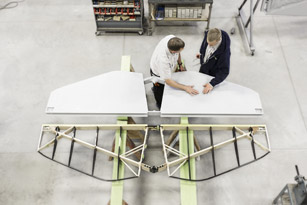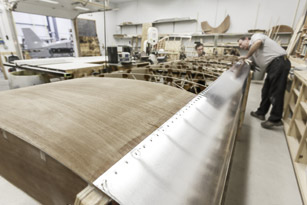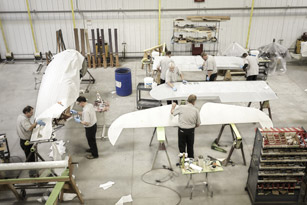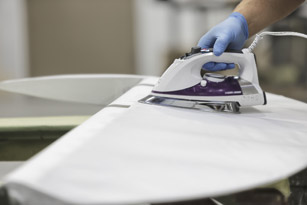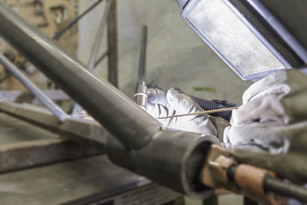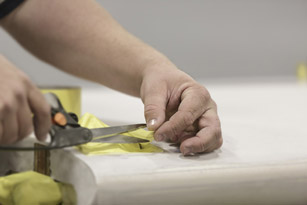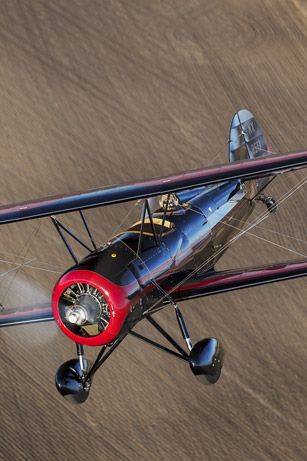
Pilots find breathtaking beauty in the curve of a propeller, the shape of a wing, even the thoughtful interface of a piece of avionics. But who makes this stuff and, in some cases, keeps it beautiful for decades? Our new occasional Craftsmanship series explores the people who create—and recreate—these things for us. We could find no better candidates to kick off the series than the impressive Redman family of Rare Aircraft. —Tom Haines
Fulfilling other people’s dreams of owning and flying exotic, exquisitely crafted, antique aircraft allows the
family behind Rare Aircraft to live its
own dream.
Roy Redman, the Minnesota company’s founder, works side by side with two sons, Jeremy and Ben, at resurrecting some of the finest airplanes of the 1920s, 1930s, and 1940s while incorporating improvements that the Redmans say make the aircraft as reliable as new ones.
“Each of our airplanes has history to be preserved and a story to be told,” says Roy, 82, a retired Northwest Airlines pilot who built model airplanes as a boy before restoring his first full-size antique aircraft in the early 1970s. “We respect those unique aspects in each airplane while we bring them up to modern standards. Where there are better processes, materials, and components available today than there were 75 years ago, we use them.”
Rare Aircraft has 15 employees and restores up to five airplanes a year at its spotless 22,000-square-foot restoration facility in Faribault, a town about 50 miles south of Minneapolis. The company is best known for re-creating all models of Waco biplanes—but it began with Roy’s own Stinson SR–8 Reliant that he restored simply because he wanted to.
“I didn’t do it to win awards or start a business, although those things eventually came out of it,” he says. “I just wanted to own and fly a really nice airplane, and I had the skills and the desire to make the airplane the way I thought it should be. That level of detail and the pursuit of perfection gave me satisfaction, just as in my model airplane work many years previous.”
“I didn’t do it to win awards or start a business, although those things eventually came out of it,” he says. “I just wanted to own and fly a really nice airplane, and I had the skills and the desire to make the airplane the way I thought it should be. That level of detail and the pursuit of perfection gave me satisfaction, just as in my model airplane work many years previous.”
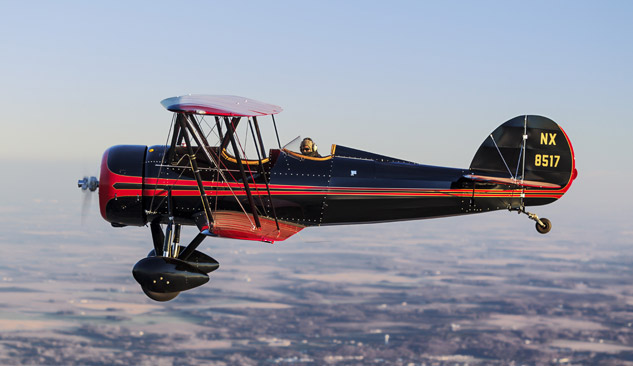
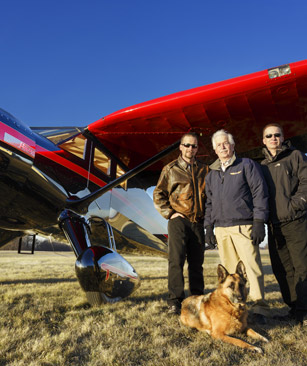
Role playing
Each of the Redmans plays a distinct role in the day-to-day operation of Rare Aircraft, although they put no weight in formal titles or organizational charts.
Roy, the founder, sets a quiet, thoughtful, understated tone for the group. He is extremely well-known in antique aircraft circles for his half-century of hands-on participation and unmatched results. He patiently deals with the FAA on the extensive list of STCs and 337s that the company incorporates on virtually all of its aircraft restorations. The wiry, silver-haired former airline captain speaks in an even, soothing voice; keeps tabs on scores of little-known exotic aircraft projects around the country; and buys dilapidated aircraft or hard-to-find parts whenever they become available. He drives an Audi A6, often with his German shepherd in the canvas-covered back seat, and classical music plays constantly through its satellite radio channels.
“When you ride with me you get the classics,” he says.
Jeremy, 40, manages every facet of the complex and interrelated work taking place on the shop floor. He oversees a skilled team of 10 technicians and answers their in-depth questions about the ways he wants them to perform detailed tasks that range from covering, to painting, to electronics and wiring on several concurrent restoration projects. Jeremy also is recognized within the family for his strong aesthetic sense and collaborates closely with customers on matters such as paint schemes and interiors.
Rare Aircraft has a clause in its contracts specifying that exterior designs must be done by “mutual consent,” and the company reserves the right to bar wild, over-the-top paint schemes that aren’t in keeping with the historical aircraft they turn out.
“These airplanes aren’t blank canvases,” says Jeremy. “They have a presence all their own. It’s easy to overdo the paint schemes and accessories. These aircraft are purchased by individuals, but they are going to represent our company for many, many years. Our general approach to paint schemes is that simpler is better.”
Ben, at 35 the younger son, focuses on mechanical work and relishes all aspects of flying—even in open-cockpit biplanes during Minnesota winters. He delves deeply into engines, props, and aircraft systems, and he performs the vast majority of the post-maintenance test flights and new aircraft deliveries. Outgoing and personable, he also markets the airplanes, represents Rare Aircraft at airshows and public events, moves exotic aircraft around the country, and provides dual instruction for many clients. Both sons are pilots, A&P mechanics with inspector authorization—and neatnicks.
The last half-hour of every workday is spent cleaning up the shop, and every airplane in the hangar is left carefully chocked with oil pans in place to catch any errant drips that might find their way to the etched cement floor.
‘They buy them to fly them’
Almost all Rare Aircraft customers visit the facility before buying an airplane, and the company’s hangar/office complex is kept ready for inspection. All employees wear Rare Aircraft uniforms, and the radio volume on the shop floor remains at a subdued level.
“Our customers are regular visitors here, and so are FAA inspectors,” Roy says. “We want to instill confidence and trust, and running a tight ship is part of it. We build quality into every aspect of our work. You simply can’t have a messy shop and add quality at the last minute. Craftsmanship has to start at the very beginning.”
AOPA turned to Rare Aircraft in 2002 to build the Centennial of Flight Sweepstakes Waco UPF–7. The two-year restoration project celebrating the 100th anniversary of the Wright brothers’ first powered flight was one of the most popular AOPA sweepstakes ever. In fact, then-AOPA President Phil Boyer became such a Rare Aircraft fan that he bought a UPF–7 from the company for personal use. And current AOPA President Mark Baker liked the Centennial of Flight Sweepstakes aircraft so much that he and a partner bought it from the winner shortly after it was awarded in early 2004.
Most buyers are seasoned aviators who seek out the company for its track record of award winners. Rare Aircraft has restored about 40 antique aircraft over the years, and the vast majority of those airplanes are actively flying. “Our customers regard their airplanes as treasured possessions, but not museum pieces,” Roy said. “They buy them to fly them.”
Rare Aircraft scours the country for antique aircraft that have fallen into disuse and surplus parts to buy. The company has an inventory of about seven undamaged but non-airworthy Waco UPF–7s stacked in upstairs storage areas. The base price for a frame-up restoration is $297,500 and takes about six months to complete. The company also takes on special restoration projects from time to time and charges an hourly rate plus parts and materials. In November, a Stinson Reliant V77 with a 450-horsepower Pratt & Whitney R-985 engine was ready to fly and only lacked the FAA blessing of its voluminous paperwork.
The company’s current backlog is about one year, and Rare Aircraft employees are working overtime to keep it from getting any longer. “We know we’ll lose business if our backlog gets too long,” Roy said. “We’d like to get it a little shorter than it is right now.” Workers typically put in four 10-hour days each week, but now they’ve added eight hours on Fridays.
The recent depression among aircraft manufacturers seems to have bypassed Rare Aircraft, even though the airplanes it produces are purely discretionary purchases for their owners.
“Our sales have increased each year during the last four years and our business is doing well,” Roy said. “It might have been doing even better if the overall economy was stronger, but we’re not complaining. We feel very good about the shape our business is in.”
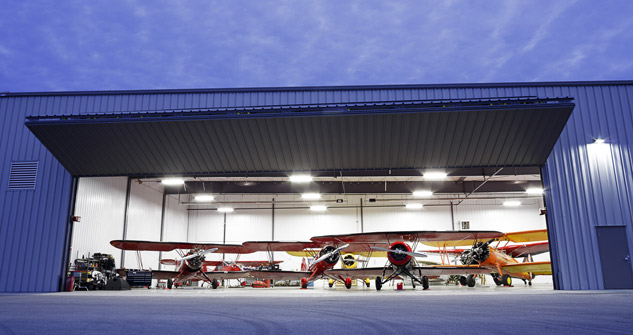
Tribal knowledge
Subfreezing temperatures and stiff northwest winds are enough to keep most open-cockpit biplanes on the ground, but Ben performs post-maintenance tests and delivery flights year round. On a 30-degree afternoon in late November, he dons an electrically heated vest, hand- and foot-warmers, and a thick leather jacket before taking up a
Waco Taperwing the company recently finished on an air-to-air photography flight with AOPA Pilot.
A 20-knot wind blows foamy streaks across a nearby lake as he climbed to 4,000 feet agl, running the Jacobs engine at full power all the way to break in the new cylinders. “I’m not supposed to have favorites,” he says. “But I sure like the way this airplane flies.”
He maneuvers the biplane beside our Bonanza B36TC photo ship and enthusiastically complies with AOPA Senior Photographer Mike Fizer’s hand signals. After a frigid hour aloft, Fizer lets him know he’s free to return to the airport, but Ben isn’t finished flying. He stays up for another 20 minutes flying a slow, graceful series of aerobatic maneuvers. The Bonanza is already tucked away in the hangar when the biplane touches down.
Ben and Jeremy grew up around the airport and their dad’s restoration projects, and have long been steeped in the culture and traditions of antique aircraft. They learned the craft of rebuilding and restoration largely by being around them. There is no formal curriculum for many of the labor-intensive, antiquated construction processes.
“A lot of the methods are passed down through generations,” Jeremy said. “It’s tribal knowledge, and to get it you’ve got to be a member of the tribe.”
Ben says he considers himself extremely lucky to be immersed in work that thrills and challenges him, and a member of a successful team of people that he loves and respects. He says he reminds himself daily not to take such good fortune for granted.
“I know that the kinds of specialized airplanes we produce could go away tomorrow and most of the world wouldn’t notice or care,” he says. “But I absolutely love what I get to do every day, and being able to work closely with my dad and brother is extremely rare. Not many families get to share the same goal or spend as much time together as we do, and I’m extremely grateful for that.”
Roy said his sons have been invaluable in making Rare Aircraft a success.
“These guys have developed abilities and areas of expertise that I’ll never have, and none of this would be possible without them,” he says. “Jeremy is like MacGyver, and there’s no technical problem that he can’t solve. Ben can diagnose engine issues long after everyone else has given up—and he’s not a bad pilot, either. I’m proud of them, and I’m proud of the work we do.”
